《药理学》课程PPT教学课件(Central Nervous Sys)12 central nervous system stimulants
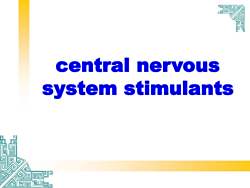
G包5centralnervousstimulantssystem
central nervous system stimulants
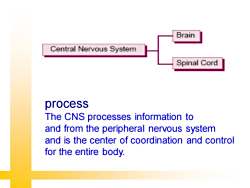
BrainCentralNervousSystemSpinal CordprocessThe CNS processes information toand from the peripheral nervous systemand is the center of coordination and controlfor the entire body
process The CNS processes information to and from the peripheral nervous system and is the center of coordination and control for the entire body
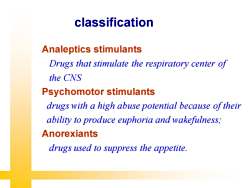
classificationAnalepticsstimulantsDrugs that stimulate the respiratory center ofthe CNSPsychomotorstimulantsdrugs with a high abuse potential because of theirability to produce euphoria and wakefulness;Anorexiantsdrugs used to suppress the appetite
Analeptics stimulants Drugs that stimulate the respiratory center of the CNS Psychomotor stimulants drugs with a high abuse potential because of their ability to produce euphoria and wakefulness; Anorexiants drugs used to suppress the appetite. classification
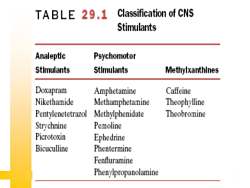
Classificationof CNS29.1TABLEStimulantsAnalepticPsychomotorStimulantsStimulantsMethylxanthinesDoxapramCaffeineAmphetamineNikethamideTheophyllineMethamphetamineTheobrominePentylenetetrazolMethylphenidatePemolineStrychninePicrotoxinEphedrineBicucullinePhentermineFenfluraminePhenylpropanolamine
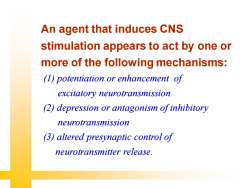
An agent that induces CNSstimulationappearsto actby one ormore of the following mechanisms:(l) potentiation or enhancement01excitatory neurotransmission(2) depression or antagonism of inhibitoryneurotransmission(3) altered presynaptic control ofneurotransmitter release
An agent that induces CNS stimulation appears to act by one or more of the following mechanisms: (1) potentiation or enhancement of excitatory neurotransmission (2) depression or antagonism of inhibitory neurotransmission (3) altered presynaptic control of neurotransmitter release
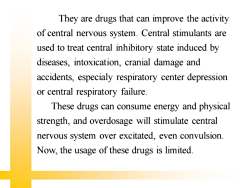
They are drugs that can improve the activityof central nervous system. Central stimulants areused to treat central inhibitory state induced bydiseases, intoxication, cranial damage andaccidents, especialy respiratory center depressionor central respiratory failureThese drugs can consume energy and physicalstrength, and overdosage will stimulate centralnervous system over excitated, even convulsionNow, the usage of these drugs is limited
They are drugs that can improve the activity of central nervous system. Central stimulants are used to treat central inhibitory state induced by diseases, intoxication, cranial damage and accidents, especialy respiratory center depression or central respiratory failure. These drugs can consume energy and physical strength, and overdosage will stimulate central nervous system over excitated, even convulsion. Now, the usage of these drugs is limited
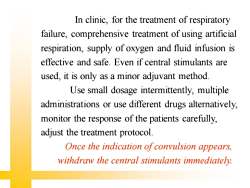
In clinic, for the treatment of respiratoryfailure, comprehensive treatment of using artificialrespiration, supply of oxygen and fluid infusion iseffective and safe. Even if central stimulants areused, it is only as a minor adjuvant methodUse small dosage intermittently, multipleadministrations or use different drugs alternativelymonitor the response of the patients carefully,adjust the treatment protocol.Once the indication of convulsion appearswithdraw the central stimulants immediately
In clinic, for the treatment of respiratory failure, comprehensive treatment of using artificial respiration, supply of oxygen and fluid infusion is effective and safe. Even if central stimulants are used, it is only as a minor adjuvant method. Use small dosage intermittently, multiple administrations or use different drugs alternatively, monitor the response of the patients carefully, adjust the treatment protocol. Once the indication of convulsion appears, withdraw the central stimulants immediately
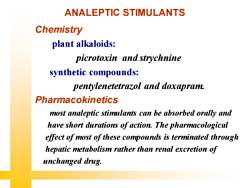
ANALEPTICSTIMULANTSChemistryplant alkaloids:picrotoxin and strychninesynthetic compounds:pentylenetetrazol and doxapramPharmacokineticsmost analeptic stimulants can be absorbed orally andhave short durations of action. The pharmacologicaleffect of most of these compounds is terminated throughhepatic metabolism rather than renal excretion ofunchanged drug
Chemistry plant alkaloids: picrotoxin and strychnine synthetic compounds: pentylenetetrazol and doxapram. Pharmacokinetics most analeptic stimulants can be absorbed orally and have short durations of action. The pharmacological effect of most of these compounds is terminated through hepatic metabolism rather than renal excretion of unchanged drug. ANALEPTIC STIMULANTS
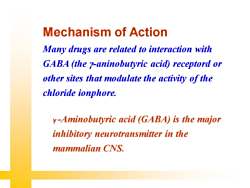
MechanismofActionMany drugs are related to interaction withGABA (the -aninobutyric acid) receptord orother sites that modulate the activity of thechlorideionphorey-Aminobutyric acid (GABA)is the majorinhibitory neurotransmitterin themammalianCNs
Mechanism of Action Many drugs are related to interaction with GABA (the γ-aninobutyric acid) receptord or other sites that modulate the activity of the chloride ionphore. γ -Aminobutyric acid (GABA) is the major inhibitory neurotransmitter in the mammalian CNS
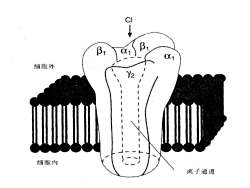
Clβ,β,-α1α1细胞外Y21111细胞内离子通道
按次数下载不扣除下载券;
注册用户24小时内重复下载只扣除一次;
顺序:VIP每日次数-->可用次数-->下载券;
- 《药理学》课程PPT教学课件(Central Nervous Sys)17 Antiparkin.ppt
- 《药理学》课程PPT教学课件(Central Nervous Sys)13 anesthesia.ppt
- 《药理学》课程PPT教学课件(Central Nervous Sys)18 neuroleptic drugs.ppt
- 《药理学》课程PPT教学课件(Central Nervous Sys)19 opioid analgesics and antagonists.ppt
- 《药理学》课程PPT教学课件(Efferent Sys)05 the autonomic nervous system.ppt
- 《药理学》课程PPT教学课件(Efferent Sys)10 adrenergic agonists.ppt
- 《药理学》课程PPT教学课件(Efferent Sys)06 cholinergic agonists.ppt
- 《药理学》课程PPT教学课件(Efferent Sys)07 adrenergic antagonists.ppt
- 《药理学》课程PPT教学课件(Efferent Sys)12 antidepression.ppt
- 《药理学》课程PPT教学课件(抗菌药物)第三十八章 抗菌药物概论.ppt
- 《药理学》课程PPT教学课件(抗菌药物)第三十九章 β-内酰胺类抗生素.ppt
- 《药理学》课程PPT教学课件(抗菌药物)第四十一章 氨基苷类抗生素.ppt
- 《药理学》课程PPT教学课件(抗菌药物)第四十章 大环内酯类.ppt
- 《药理学》课程PPT教学课件(抗菌药物)第四十三章 人工合成类.ppt
- 《药理学》课程PPT教学课件(血液与内分泌系统药物)第三十四章 肾上腺皮质激素.ppt
- 《药理学》课程PPT教学课件(血液与内分泌系统药物)第三十三章 作用于血液及造血器官药物.ppt
- 《药理学》课程PPT教学课件(血液与内分泌系统药物)第三十六章 甲状腺激素和抗甲状腺药.ppt
- 《药理学》课程PPT教学课件(血液与内分泌系统药物)第三十五章 胰岛素及口服降血糖药.ppt
- 《药理学》课程PPT教学课件(心血管系统药物)第二十五章 抗心律失常药.ppt
- 《药理学》课程PPT教学课件(心血管系统药物)第二十三章 利尿药及脱水药.ppt
- 《药理学》课程PPT教学课件(Cardiovascular Sys)28 Agents Used in Hyperlipidemia.ppt
- 《药理学》课程PPT教学课件(Cardiovascular Sys)27 treatment for CHF2.ppt
- 《药理学》课程PPT教学课件(Cardiovascular Sys)29 treatment for angina pectoris.ppt
- 《药理学》课程PPT教学课件(Cardiovascular Sys)20 anti-inflammation drugs.ppt
- 《药理学》课程PPT教学课件(Cardiovascular Sys)23 diuretic.ppt
- 《药理学》课程PPT教学课件(Cardiovascular Sys)25 treatment for arrthymia2.ppt
- 《药理学》课程PPT教学课件(Endocrine Sys)35 insullin.ppt
- 《药理学》课程PPT教学课件(Endocrine Sys)34 adrenocortical hormones.ppt
- 《药理学》课程PPT教学课件(Endocrine Sys)36 thyroid drugs.ppt
- 《药理学》课程PPT教学课件(Antimicrobial Drugs)43b Sulfonamides and other Synthetic Antimicrobial Drugs.ppt
- 《药理学》课程PPT教学课件(Antimicrobial Drugs)43a Quinolones and Urinary Tract Antiseptics.ppt
- 《药理学》课程PPT教学课件(Antimicrobial Drugs)41 Aminoglycosides.ppt
- 《药理学》课程PPT教学课件(Antimicrobial Drugs)42 Tetracyclines, Chloramphenicol.ppt
- 《药理学》课程PPT教学课件(Antimicrobial Drugs)38 Principles of Antimicrobial Therapy.ppt
- 《药理学》课程PPT教学课件(Antimicrobial Drugs)40 Macrolides, Lincomycin, Clindamycin.ppt
- 《药理学》课程PPT教学课件(Antimicrobial Drugs)39 Inhibitors of Cell Wall Synthesis.ppt
- 《生物药剂学与药物动力学》课程教学大纲 Biopharmaceutics and Pharmacokinetics.doc
- 《生物药剂学与药物动力学》课程教学资源(教案,2012版).doc
- 《生物药剂学与药物动力学》课程教学资源(讲稿,2014版).doc
- 《生物药剂学与药物动力学》课程教学资源(试卷习题)试卷6(答案).doc
